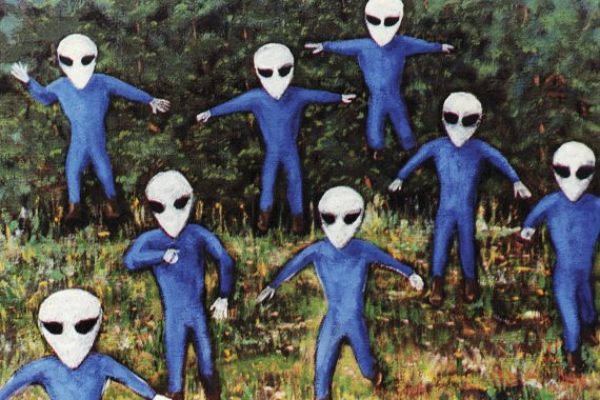One of the more interesting characteristics of our human natures is the way in which vast, even centuries-long, debates can be carried on concerning matters that are entirely devoid of physical or natural objects. Philosophy is one such; theology is another: all items of common earthly existence—bodies, things, obstacles, tools, journeys, royal or papal writs—are, in such debates, simply names: metonyms for the abstractions that do the arguing, the theorizing, the struggling, and the examining in the discourse. (That persons were sometimes sent to very real deaths by fire or the axe for questioning the standing of a theological discourse doesn’t make the paper pages less abstract in content.)
Something similar (minus the auto-da-fé) seems to be happening among the government bodies and agencies that study the evidence of UAP (“Unidentified Aerial Phenomena”), the term that is replacing the older UFOs (“Unidentified Flying Objects”). In June of this year, the Office of the Director of National Intelligence issued a “Preliminary Assessment” of the evidence for such phenomena, which was met with weeks of reporting from major news outlets—mainly spurred by simply the idea of a government report on UFOs, since the report itself, nine pages in total, is light on details. In particular, the report was meant to serve as an intelligence assessment of the threat posed by UAP, and provide an update on the progress the Department of Defense Unidentified Aerial Phenomena Task Force (UAPTF) has made in understanding this threat.
Are UAP a threat? Has that been determined? The authors of the report were clearly hindered by the fact that the discourse is about a set of things that (insofar as we know, anyway) investigators have never touched in actuality. Of all the questions that have been raised about what we mostly still call UFOs, the top-most question is: What are they? And the second-most comes on right after: Where have they come from? They are some sort of something that can’t (so far) be weighed, examined, dismantled, copied, or assigned a provenance. It seems impossible that the objects have any sort of earthly origin, and some can be shown to have no origin at all: a mere passing mirage or atmospheric oddity, a hoax or a hallucination. In fact, they may not be actual objects in the usual sense of the word, and therefore are not actually flying. It would be foolish to hold as a certainty that the unidentified phenomena are objects, though they’re almost always perceived to be objects; but there is no evidence that they have been proven to be solid or in any other way made of matter. We haven’t downed and examined one, or put a hand on one—unless we have, but haven’t been shown that we have.
The glowing disks that a surprised airplane pilot, Kenneth Arnold, first saw in 1947, flying over Mt. Rainier, have disappeared from sight; the mysterious metal shards the discs were said to have ejected turned out somehow to be plain pig iron when collected. But the true first appearance of the things (there isn’t any unity about what noun should be used in describing them) came long before, in the last years of the nineteenth and the first of the twentieth centuries, in the near destruction of the Earth’s cities and peoples by super-intelligent beings from a planet within our solar system: Minds that are to our minds as ours are to those of the beasts that perish, intellects vast and cool and unsympathetic, H.G. Wells wrote of them. Such a description could only have been made after the Martians had invaded, caused widespread destruction, been defeated, and could be studied. Wells, chronicler of that terrible time, wrote about it in his account The War of the Worlds (first serialized in 1897): all the unbelievable events, the amazing salvation, the worldwide alliance in defense of Earth that we knew then must last for centuries to come. The opening chapter of his famous history is retrospective: looking back on the war, pondering what can be pondered about the Martians, their failing home world, and what they intended to gain by invasion. With instruments and intelligences such as we had scarcely dreamed of, they saw, at its nearest distance, “only 35,000,000 miles sunward of them, a morning star of hope, our own warmer planet, green with vegetation and gray with water, with a cloudy atmosphere eloquent of fertility.” The Martian attacks on Earth reached the United States in 1938, causing death and destruction, but ending in the same way, with Orson Welles (in his infamous radio adaptation) picking up from Wells the final words: “There before my eyes, stark and silent, lay the Martians . . . killed by the putrefactive and disease bacteria against which their systems were unprepared . . . slain, after all man’s defenses had failed, by the humblest thing that God in His wisdom put upon this earth.”
Every twentieth-century visitation from that planet of inhuman beings with fabulous weapons, bent on conquest, has been virtual, not actual—as thin as a movie screen, a vivid poster: Mars Attacks the World (1938, issued just weeks before the Welles broadcast) but caused no harm; nor did The Day Mars Invaded Earth (1963), Invaders from Mars (1953 and 1986), and a dozen others. They couldn’t even scare us by then, much less exterminate us. The Red Planet, we now know, is quiescent, uninhabited, almost certainly devoid of life, its underground springs doubtful.
So where do the things we now call UFOs and UAP really come from? From nowhere in our solar system, it would seem: not from the frozen stony worlds of Pluto and Neptune, nor the gas giants, nor from the heat and acid rainclouds of Venus. From farther away, then—much, much farther away, inconceivably far: from planets or environments that a beam or beacon of Earth-light would take years to reach, traveling at 186,282 miles per second. Even if they knew about us—minds that are to our minds as ours are to the beasts, etc.—they would still have to travel a long way before they would reach our (possibly disappointing) world—unless, of course, they can surpass the speed of light, which our team at home mostly believes to be impossible. But, like our own explorer machines sent out into the cold and dark, isn’t it likeliest that those coming from faraway worlds would be mechanical rather than biological, drones rather than ships or flying machines? Although such beings may be so entirely different from any lifeform we know or can conceive that how they might get here is in fact the least of the puzzles or dangers they’d pose.
Astronomy by now has gathered up and notated as many as 40 billion Earth-sized planets orbiting in habitable zones around Sun-like stars and red-dwarf stars strewn within the Milky Way galaxy, all at distances between 12 and 50 light-years away from Earth. Such distances are dizzying to contemplate but do give a way to think of visitors from space, whom we can’t really picture, in spacecraft we can’t get hold of: If we can’t reach other worlds easily, why do we believe other beings can come here? And why would intelligent beings residing so far away set out for our home planet anyway? Wouldn’t they be invested in exploring planets nearer to themselves, some a mere 30 million miles off, as Mars is to us? What would cause them to pick on a little planet, “green with vegetation and gray with water,” but many more light-years away? Is it because they have powers or machines so advanced that the trip, a mere 24 trillion miles or so, would be quick? All we can see now is the chariot-race shown on the science channels—small bugs caught in the pincers of geometry, skipping over an interminable dark-clouded sky. Are they advance explorers from the deeps of the universe, and, if so, what are they seeking to know?
Because we can’t fix them in our everyday minds, the phenomena must somehow be seen in the totality of human perception happening everywhere and all at once. Carl Jung became fascinated with the “flying saucers” of the 1950s, theorizing that UFO sightings resembled portents that in the past were interpreted as premonitions of war and pestilence. He thought the appearance of such objects afforded the opportunity for potent myth-making—projections that the ancient star-pictures we see above us had always allowed.
Portents in digital space, as pervasive and spooky as Wells’s dark imaginings or as hopeful as Jung’s vision, might be as close as we’ll ever get. Betsey Lewis, author of Angels, Aliens and Prophecy II: The Angel-Alien Agenda (2013) and other accounts, had her first experience of a large disc, glowing but not unfriendly, in the sky above her when walking home from first grade; she experienced similar encounters often thereafter. The line she draws between UFOs and angels (who also have no material substance) is appropriate in the context of unknowable Others: Dr. Guy Consolmagno, the head of the Vatican Observatory—sometimes called “the Pope’s astronomer”—has asserted that Catholic intellectual tradition would have (in one interviewer’s summation) “absolutely zero problem” with the idea of intelligent life on other planets—that is, substances of a rational nature (the Church’s definition of a “person”). Questioned if he’d be willing to baptize an alien, he said, “Only if she asked.”






